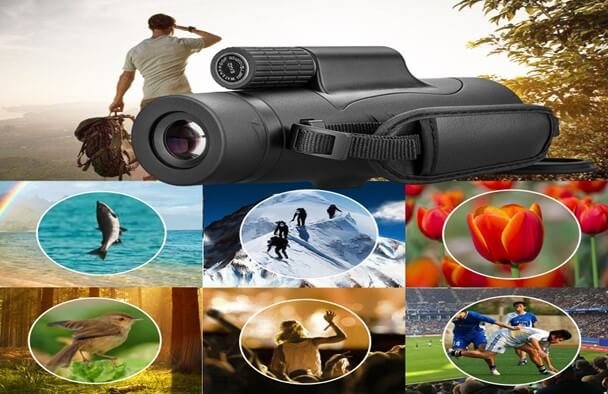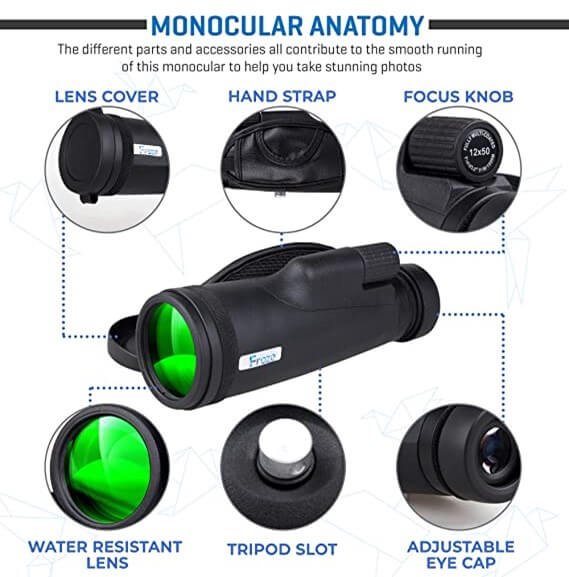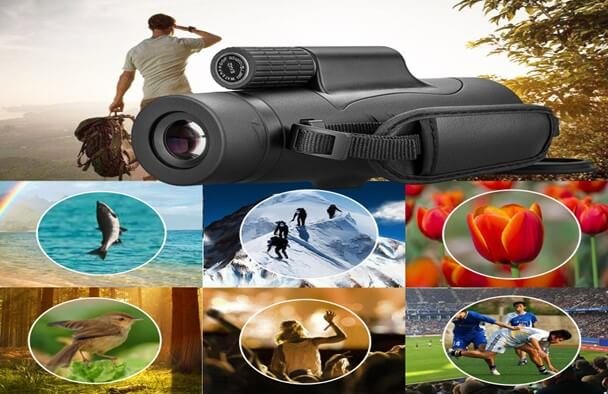What is a monocular?
A monocular is a single-scope binocular. It is an optical instrument that clearly magnifies distant objects and, in some cases, allows you to take a photo as well.
One of the golden rules of backpacking is to keep the weight down and keep everything as compact as possible. Therefore, if you are going out for a hiking trip and need to pick up some binoculars, you should instead consider the best monocular for hiking. The major advantage of a monocular is that it is essentially less cumbersome and will not burden us much.
Another thing is that the monocular is quite lightweight and small enough to fit inside a pocket or accessory pouch. It’s ideal for backpacking because you definitely don’t want bulky binoculars dragging your neck down all day long. It’s also an inconvenient to remove your pack to access your oculars. In addition, with the lens on the front, the eyepiece at the rear, and usually a large and clear focus knob in the middle, the best monoculars for hiking can be used comfortably with just one hand.
Why should you take The Best monocular for hiking?
For most recreational birders, wildlife enthusiasts and nature lovers, a monocular is often just as powerful as comparable binoculars. If you are the type of hiker or backpacker who wants complete control over their travels and enjoys nature to the fullest, then Monocular is a must-have for you. This will add to the comfort and enjoyment of your journey while not adding weight. The best monocular for backpacking and hiking offer tremendous value to the user. Therefore, it is very important to have knowledge about the best ones and choose them correctly. The idea is to keep the weight and bulk of your gear to a minimum on your next backpack for hiking.

So, are you ready to take a monocular on your next trip? Let’s talk in detail about what to look for, what to avoid and how to choose:
Budget and Use
As ever, when it comes to selecting a monocular, you have to first decide on two things, the budget and what you will use it for. For simple landscape viewing, you may go for a different quality than a bird watcher. Undoubtedly, a larger monocular might be more appropriate for birders. You’ll have to upgrade if you want high-quality contrast and resolution, which will also increase the weight and size of the monocular. Practically, one would want to emphasise the heavier models for a day hiking, and the lighter ones for backpacking. No one wants to carry around any more weight than required on a long backpacking trip.
Depending on your budget, it is possible to find a compact monocular of great quality.
Magnification
High magnification is good for distant subjects but it’s hard to keep the scene steady; Low magnification is good for wide natural scenes or fast-moving subjects. It is important to pay attention to the zoom settings while choosing a monocular. The higher the magnification, the smaller the field of view. This would be ideal for those who want to zoom in on the distant mountains. However, the small field of view can be difficult when trying to locate near objects such as a bird.
With a narrow field of view, even a high powered monocular can be difficult to stabilize. Small movements of the hand or body can be unnecessarily unstable when viewed through a high-zoom lens. If you don’t have the steadiest hands, you can opt for a lower zoom power.
Lens Size
The two most essential things before you buy a monocular for a crisper and a brighter image are the lens and magnification diameter.
A larger lens will collect more light and give you a clearer image in the dark or in the light but will add size, weight, and cost.
When you go to buy a monocular, you’ll find size information like this: 10 x 42. If you don’t know what that means, let’s break it down:
The first number, (10) indicates the magnification or power of the device. We talked about its effects above.
The second, (42), represents the diameter of the lens in millimetres. Because we’re looking for compact monocular, a diameter of 30-35 is probably an absolute maximum. Among other things, the diameter of the lens will dramatically affect the light collected. However, at higher diameters, this can be problematic on the size. Don’t go too high on the lens, you’ll lose the compact advantage.
Eye relief
Eye relief is the distance from the monocular to the focal point. If that’s 15 mm, you need to hold your mono 15 mm away from your eye. If you are using glasses, buy a monocular with more eye relief. This will reduce the hassle for you as your glasses will not come between the distance and you will adjust the distance easily.
Tripod Mount
If you go for hiking and you want a long and accurate wildlife-watching session that require hands-free viewing and a still image. So, a tripod-mounted monocular is essential.
Waterproof and Fogproof
A monocular is often used and carried in outdoor environments where it may be exposed to water, fog, dust, and shock. So, it should be waterproof, fog proof and shockproof. In addition, it needs to be sealed so that no dust or water can enter.
These are some basic features that you need to consider while selecting a monocular. For a detail review on monocular, read my “The Best Monocular For Hiking! Tried And Tested”

What we had talked about:
A monocular is both lighter and smaller than regular binoculars, and we look for a monocular that is lightweight, of good quality, and that will withstand the rough use of the day-to-day activity of bird watching and wildlife spotting and be able to cope with all your needs. I hope you enjoyed reading this article, if you want to know more about the best monocular on the market, you can read my article “The Best Monocular For Hiking! Tried & Tested.!” so, for now, Be Safe And Have Fun.

